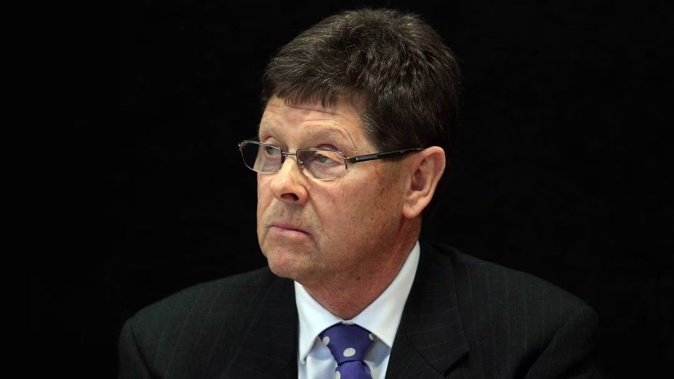

A man, whose company was responsible for designing the six-storey Christchurch building that collapsed in the February 2011 earthquake killing 115 people, has been accused of putting people’s lives at risk in one of the “worst engineering failures in the country”.
Dr Alan Reay, who owned Alan Reay Consultants, was criticised by the families of those killed for allowing his inexperienced structural engineer David Harding “sole responsibility” for designing the Canterbury Television (CTV) building when he knew the engineer lacked the necessary experience.
The complaint was initially raised in December 2012 and Reay has been fighting the process to have it heard ever since.
Today a long-awaited disciplinary hearing began, 12 years after the tragedy, in front of family members of the 115 who died when the building collapsed.
Firefighters, police and other search and rescue crews at work on the collapsed and burning CTV building in central Christchurch. Photo / Mark Mitchell
In the aftermath, the Canterbury Earthquakes Royal Commission found the structural design of the CTV building was seriously deficient in multiple ways and Reay knew his engineer Harding was inexperienced but failed to adequately supervise him, Engineering Disciplinary Tribunal chairman Andrew McMenamin said in outlining the complaint against Reay.
Spokesperson for the CTV families Dr Maan Alkaisi said their experience of losing loved ones was made even more painful by the lack of accountability by Reay.
He said the families had been waiting for the disciplinary process for 12 years, which had prevented closure and taken an additional toll on the process of mourning the deceased.
“We have been mourning our loved ones for the last 12 years. We remember our loved ones on every special occasion.
- Police confirm decision not to lay charges over CTV building
- Andrew Little: Law changes possible after CTV building engineers escape charges
- Investigation into CTV building collapse reaches 'final stages'
- Police complete criminal investigation into collapsed CTV building
“Some victims were buried alive, others were cut into pieces. For some of our loved ones, no traces could be found, not even any DNA that could identify them.”
/cloudfront-ap-southeast-2.images.arcpublishing.com/nzme/S4E5ENDBX7GVEQVZLFQLF5GBOI.jpg)
The CTV building has become a symbol of the February 2011 earthquake after it collapsed and killed 115 people. Photo / Mark Mitchell
Alkaisi said Reay “risked people’s lives”, resulting in “one of the worst engineering failures in the country” and since the tragedy, had not taken accountability.
“The CTV families also believe Dr Reay was fully aware of the design deficiencies and had two opportunities to rectify the problems.”
He said the families welcomed the disciplinary hearing process and hoped it would help to ensure the tragedy was not repeated.
Reay’s lawyer Kristy McDonald, KC, said Reay, who did not attend the hearing, wanted to acknowledge the CTV families, stating the 82-year-old was deemed “medically unfit” and it was “no disrespect” to the families that he was not present.
/cloudfront-ap-southeast-2.images.arcpublishing.com/nzme/W55DEQIX4FGBDK65UAURKGQW6Q.jpg)
Police and volunteers work to rescue people trapped in the collapsed CTV building. Photo / Geoff Sloan
McDonald raised concerns about additional information being presented to the disciplinary committee at late notice, without giving her client the opportunity to look through it.
She said the purpose of the hearing was not to be a “trial by ambush” and if the committee held personal views against Reay or herself, this must not influence their approach to the disciplinary hearing.
The committee heard from Dr Wayne Stewart, who chaired Engineering New Zealand’s investigating committee at the time the investigation was carried out.
In questioning Stewart, McDonald accused him of going outside of his jurisdiction, which was “highly prejudicial” to her client.
Stewart denied this, stating he carried out the investigation to determine whether the complaint against Reay should be referred to the Disciplinary Committee. He said he found sufficient evidence that it should.
/cloudfront-ap-southeast-2.images.arcpublishing.com/nzme/FNDGWUYGTTDKTLBTF6CIAJZLJ4.jpg)
A memorial to the people who died in the CTV building collapse in Christchurch. Photo / Mark Mitchell
Reay released a statement this morning stating the long process to get to this point had “allowed false assumptions to take root and fester”, claiming it had stigmatised him and taken a “heavy toll.”
Reay strongly denied the allegations, stating he had good reason to believe Harding was sufficiently competent to undertake the work he did.
The statement said the allegations at the centre of the complaint related to a time when there were no relevant professional standards requiring the supervision of a senior registered engineer such as Harding.
“Dr Reay wishes to acknowledge and thank all those who have stood by him and his family over the many years of intense scrutiny and persecution that this matter has perpetuated.”
In September this year, Reay sought a judicial review of the complaint process by Engineering New Zealand, formerly the Institution of Professional Engineers (IPENZ), in the High Court at Wellington.
Reay’s lawyer argued the complaint laid against him was “stale, no longer relevant and utterly futile,” urging the judge to dismiss it.
In October Justice Paul Radich dismissed Reay’s request for a judicial review stating there was “genuine public interest” in having the complaint heard.
The complaint against Reay was first raised in December 2012, after the release of a Canterbury Earthquakes Royal Commission report, which found Reay breached the 1986 IPENZ Code of Ethics.
The complaint was dropped for some years after Reay resigned his membership of the engineering professional body, but was reopened in 2019.
The disciplinary hearing is expected to take three days.
Emily Moorhouse is a Christchurch-based Open Justice journalist at NZME. She joined NZME in 2022. Before that, she was at the Christchurch Star.

Take your Radio, Podcasts and Music with you

/cloudfront-ap-southeast-2.images.arcpublishing.com/nzme/UEQUYPZDNRAVFNWBGSDRM4GOVQ.JPG)








